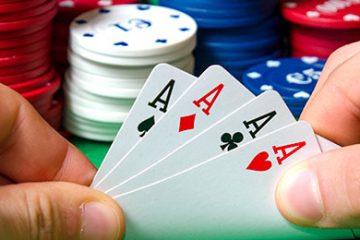Poker is a card game that has really captured the imaginations of a lot of TV viewers and gamblers in recent years. In order to be a successful poker player, you will need to be able to quickly calculate poker odds.
Calculating poker odds is essential in order to evaluate your chances of winning any given hand. To be able to do this you need to know how many outs or ways to win your current hand has. Knowledge of this helps you immensely and will become second nature after a little practice.
Becoming a good poker player means that you will need to work out poker odds quickly. This might sound like a complicated affair, but once you get the hang of it you will find it to be quite easy. Here you will learn everything you need to know about calculating odds in poker and how to use this skill to your advantage.
Calculating Poker Odds

In order to calculate the odds when playing poker, you need to look around at what you know. For example, you know which cards you have and what the community cards are, but there are many unknown variables in the form of other players’ hands.
You will be well aware of how many cards there are which can help you win your hand. These cards are known as outs. For example, you might have two clubs in your hand and there might be a further two among the community cards right after the turn card has been dealt. There are 46 more cards, including those of any opponents, and 9 of those cards are clubs which would help you get your flush. The chances of winning at this point are 37 to 9 or close to 4/1.
You need to consider what an opponent might have. What could he have that’s better than your hand? Let’s assume that one of the community cards is the ace of diamonds. You can assume that he perhaps has an ace and is chasing three of a kind. Only 2 cards will see him win from the 46 remaining. The odds of him winning are 46/2 or 23/1. Your chances of winning are greater, but it is based largely on assumption. He could be chasing the same flush as you or he could already have three of a kind.
It can be tricky, but knowing your own odds is a huge boost. Many players don’t even consider this part of the game at all and it will give you a distinct advantage.
You can calculate the probability of victory after the turn card has been dealt in the following way:
Total unknown cards minus the total number of outs, divided by the total number of outs.
Using the above example: 46-9/9 = 4.1
The probability is 4.1/1.
Your ability to quickly calculate poker odds in this way will really help your game.
Total Number of Outs
In the above example you have 9 outs and if your opponent is looking for an ace, as you suspect, he has 2. The more outs you have, the bigger chance you will have of winning. Your odds are smaller than your opponents and the lower the better when it comes to poker odds.
If you have only 1 out then the odds will be 45/1, but if you have 18 outs the odds decrease to a much more favourable 1.6/1.
Knowing how many outs you have is essential for being able to accurately calculate your odds of winning. It is purely speculation when it comes to calculating your opponent’s odds – they could be bluffing too, don’t forget – but if you assume they have a better hand than you when calculating their theoretical odds, you give yourself a greater chance.
Knowing When You Should Call

Calculating your odds is one thing but applying this knowledge to when you should call is a different matter. You still need to keep a level head. If your odds are 1.6/1 you don’t want to scare away other players and immediately go all in, for example.
Before calling you should look at what’s in the pot and decide if it’s worth your while. Winning is important, but so is getting good value for money.
If we use the above example once more with odds of 4/1, you would want to see that kind of return on your money if you were to call. Let’s say the pot contains $50 and your opponent bets another $10 to make it $60. You would then have to part with $10 to call. A $10 bet to potentially win a pot of $60 is odds of 6/1. A 6/1 payout for a bet that is worth 4/1 is of course great value and you should absolutely call at this point.
Conversely, if the pot was below $40 it would mean that you were getting poor value for money and the best course of action would really be to fold.
Winning Isn’t Guaranteed
Just because you know you have really good odds and you suspect your opponent has a hand with higher or worse odds doesn’t mean that you will win. 4/1 means you will win 1 in 4 times – that means that 3 times you will lose in the same circumstances. And even though the odds on your opponent winning are 23/1, it doesn’t mean that it’s impossible for him to win rather than you.
Bear in mind that poker odds are an indicator of who is most likely to win, but not who will actually win.
Knowing Your Odds
Poker is an odds-based game, of that there is no doubt. As well as being able to calculate the odds of winning with the hand you have and the odds of your opponent winning with the cards he has, you should also know the odds of some of the most common hands in poker.
Here are some of the most common poker hands and their odds on the turn:
- Open-ended straight – 4.8/1
- Flush – 4/1
- Inside straight – 10.5/1
- Two pairs – 8.2/1
- Three of a kind – 22/1
You should study a poker hands chart in order to learn the odds on different hands and commit them to memory in order to help you become a better poker player.


0 Comments